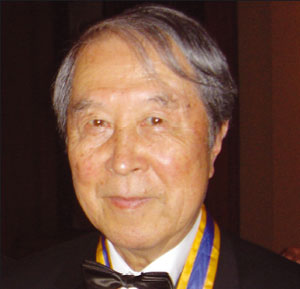Broken symmetry in particle physics is the underlying theme for the 2008 Nobel Prize in Physics. Yoichiro Nambu, emeritus professor at the University of Chicago, has received a half share of the prize “for the discovery of the mechanism of spontaneous broken symmetry in subatomic physics”; Makoto Kobayashi, emeritus professor at KEK, and Toshihide Maskawa, former director of the Yukawa Institute for Theoretical Physics at Kyoto University, share the other half “for the discovery of the origin of the broken symmetry which predicts the existence of at least three families of quarks in nature”. The work of the three theoreticians underpins significant parts of the current Standard Model of particle physics, and is also reflected in key questions that are driving current experimental research in the field.

Nambu left his native Japan for the US in 1952, and has been at the University of Chicago since 1958. He has made several important contributions to particle physics, but it was the theory of superconductivity published in 1957 by John Bardeen, Leon Cooper and Robert Shrieffer that led Nambu towards spontaneous symmetry breaking in particle physics. In 1960 he looked at how to maintain gauge invariance (the underlying symmetry of electromagnetism) in a field theory of superconductivity – a phenomenon that spontaneously breaks gauge invariance (Nambu 1960). He went on to develop these ideas in field theories for elementary particles, and to bring in the concept of spontaneously broken symmetry not just in matter but in empty space (CERN Courier January/February 2008 p17). In particular, this led to ideas about the generation of mass (Nambu and Jona-Lasinio 1961).

Three of the people who took note of these ideas were Robert Brout, François Englert and Peter Higgs, whose work is now encapsulated in the Brout–Englert–Higgs (BEH) mechanism for generating mass through spontaneous symmetry breaking in the Standard Model (CERN Courier October 2008 p83). All three acknowledge Nambu’s influence on their work in 1964. Some 40 years later, the search for the scalar boson (Higgs particle) associated with the field required by the BEH mechanism is an important element in the physics to be studied at the LHC at CERN.
In 1972 two Japanese theorists at the University of Kyoto began to look at a different broken symmetry. Kobayashi and Maskawa decided to investigate the violation of CP symmetry in weak interactions (which had been discovered in the neutral kaon system in 1964) in the context of renormalizability. At the time only three quarks were known, but building on work on unitary symmetry in weak decays by Nicola Cabibbo and the need for four states to suppress strangeness-changing neutral currents, Kobayashi and Maskawa concluded that “no realistic models of CP violation exist in the quartet scheme without introducing any other new fields” (Kobayashi and Maskawa 1973). However, one option that they showed would work was to broaden the quartet of states to six. This led to a 3 × 3 unitary mixing matrix, which included a phase that imposed CP violation in certain transitions. The paper did not arouse much excitement at first, but within the next two years, not only was the fourth quark, c, discovered, but also a third charged lepton, τ, indicating a third generation of leptons and hence a third generation of quarks.
Since then, not only have the fifth and sixth quarks, b and t, been discovered, but CP violation has also been found in the neutral b-quark system, the B-mesons. The Cabibbo–Kobayashi–Maskawa matrix has become an intrinsic part of the Standard Model, which is being tested with high precision with neutral kaons and in particular with B-mesons at the B-factories and in future at the LHC. At the same time, CP violation in general remains a puzzle, as the effect observed in weak interactions is by no means sufficient to account for the domination of matter over antimatter in the universe.
Further reading
M Kobayashi and T Maskawa 1973 Prog. Theor. Phys. 49 652.
Y Nambu 1960 Phys. Rev. 117 648.
Y Nambu and G Jona-Lasinio 1961 Phys. Rev. 122 345








